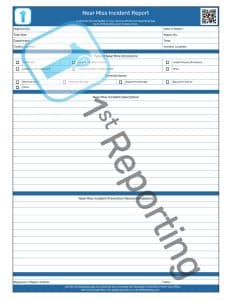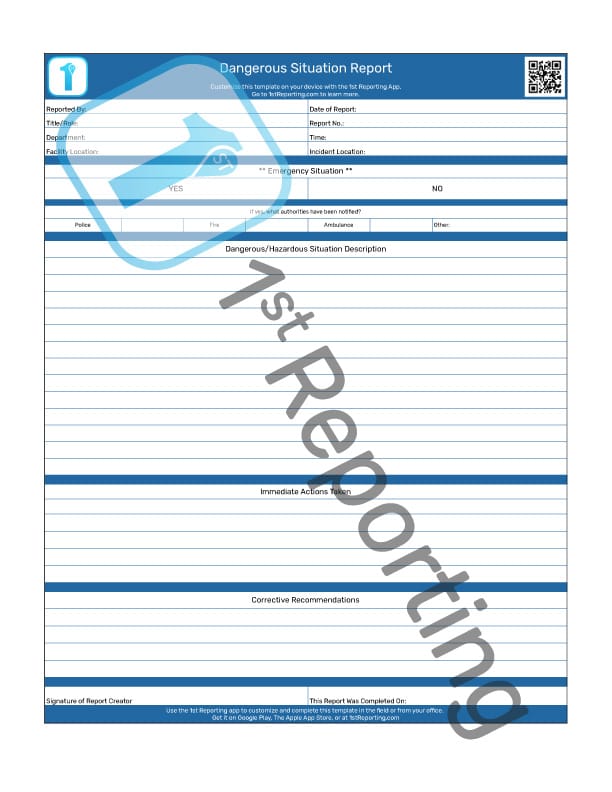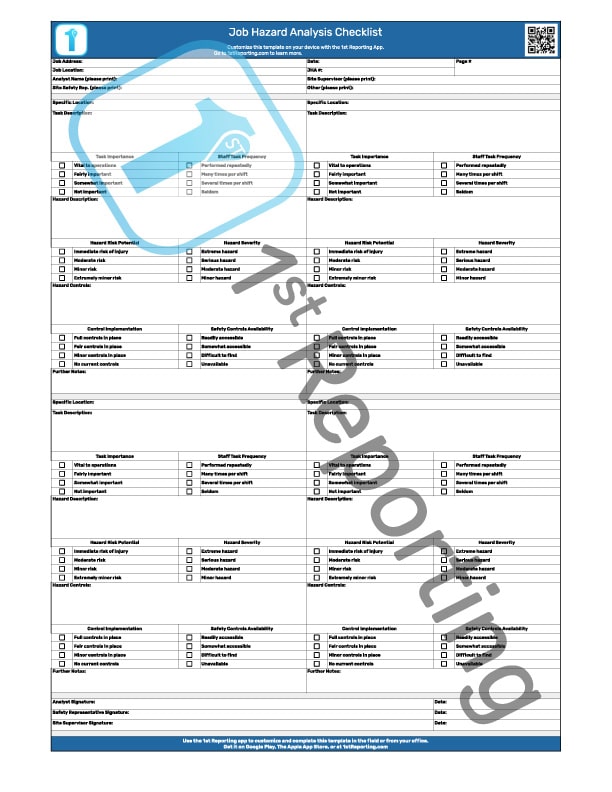
Looking for a Near Miss Report Template? When accidents occur, our first thought is to be reactive in our response to the accident. We attend to injured, secure unsafe conditions, and, of course, call the pertinent authorities when required. But preventing these incidents can save a lot of reactive energy, time, money, and most importantly, avoid injuries. For this purpose, we bring you our Near Miss Report.
A Near Miss Incident Report is a report that details a place, equipment, or scenario where a potential accident or incident almost occurred. The details reveal how preventive measures can help eliminate the potential for an accident or incident causing injury or property damage.
Ask anyone who has been injured in the workplace or anywhere for that matter, and they’ll tell you they’d be better off if the injury were avoided. Sometimes those situations happen where no one was injured, but someone says, ‘That was close!’. These situations can be difficult to coax staff to admit or worse – to file a report.
In this article, we’ll not only provide you with a downloadable Near Miss Incident Report form, but we’ll also help to provide some clarity to the near-miss reporting process. Before we do, let’s take a quick look at the form.
Included In The Near Miss Incident Form
The Near Miss Incident Report form includes five critical sections for your near-miss reporter to include vital information. These critical sections include:
- Administrative report data
- Type of near-miss incident and hazard
- Description of event
- Recommended measures
- Report sign off
These sections of the report are relatively self-explanatory. However, there are a few key ingredients to each that ensure a useful report. We’ll go into more detail in the following section.
How To Use The Near Miss Report Template
Using the Near Miss Incident Report form is simple, download, print, and fill it out. But there is more to it than just filling out the form. There are a few guidelines that ought to be included within the boundaries of this report. Unlike a digital reporting solution like the 1ST Incident Reporting App, the form cannot add or remove sections for customization. The proper use of the form is required for optimal results.
The beginning area of the form is merely an administrative formality yet must be completed clearly and accurately. The administrative section includes the essential details that outline the report writer’s identity and the date/time/location that the near-miss occurred.
Following the administrative section is a quick-view, or ‘snapshot’ of the near-miss incident itself. With checkbox response, it’s easy to get a quick view of the nature of the occurrence type and potential hazard identification.
The Near Miss Incident Report’s most crucial area follows and includes all of the details and information of the near-miss. It is this section where the reporter ought to include the following:
- Details of the situation leading up to the near-miss
- Details of the near-miss incident itself, how it ‘played out’ via a timeline
- Details of immediate actions taken (if necessary) to isolate any hazards
- Names of any immediately affected by the near-miss (if applicable)
The next area on the report form is another text area where the reporter should note recommendations for optimally preventing another near miss. The recommendations ought to find completed in as much detail as possible. Staff needs to maintain a team-oriented attitude to file in this section properly, as many staff may fear that these sorts of reports could be taken as ‘correcting a manager.’ This situation may be avoided by instilling a healthy, team-oriented safety culture.
Near Misses And The Benefits Of Reporting Them

When someone in the workplace says, ‘That was close!’ it’s a reason to fill out a report. Any time there is a near-miss occurrence, if properly documented and managed, it can turn the occurrence into a simple improvement lesson for a company. It would be a shame to allow dangers to go unchecked and potentially cause damage to property, equipment, or worse, injury to a person.
A team-oriented approach to safety accomplishes a successful safety reporting regimen. The most prominent benefits of a prudent near miss reporting procedure may be evident to some, but there are also some not-so-obvious benefits. Here are a few of the key benefits your company can find by using a Near Miss Incident Report Form or even a more sophisticated reporting procedure like the 1ST Incident Reporting App.
- Prevent Injuries
- Prevent Equipment Failure
- Prevent Untimely Operation Stoppages
- Increase in Staff Safety Awareness
- Inspire A Culture Of Facility And Process Improvement
Near Miss Reporting Procedures Tips
Near-miss reporting has two different problems that many companies face attempting the report’s implementation into their safety practices. The first is a fear of reprisals, and the other is a fear of hurting others’ feelings.
Eliminate The Fear Of Reprisals
There are several ways to eliminate the fear of reprisals from staff reporting potential hazards and near misses. There will always be issues when the near-miss is caused by staff acting haphazardly. The situation calls for a strict culture of professionalism, dissuading horseplay in the workplace. Secondary to this is the managerial role of providing training to employees to foster the team-oriented attitudes desired and necessary for a transparent reporting system.
Companies have defeated the fear of reprisals by reporting near-miss incidents by adding anonymity to the reporting process. It can be offered in an anonymous suggestion box if the work culture happens to dissuade reporting practices.
Eliminate The Fear Of Hurting Others Feelings
In a workplace where custodial or maintenance staff are responsible for conditions that could cause a near miss or even an incident, there is an understanding that reporting said conditions might affect the livelihood of those responsible. In work environments where employees ‘look out for each other’ when reporting to management, a near miss is often ignored for fear of getting someone ‘in trouble.’ Or, even more heart-felt, hurting someone’s feelings by criticizing their ability to maintain a safe working condition.
When staff fears hurting someone’s feelings or fear getting someone else in trouble, they will often keep near-miss incidents to themselves. Developing a safe working environment requires that all staff join in on a team-oriented reporting practice without fear of reprisals. Subsequently, staff must also learn or be trained the communication skills needed to confront their fellow employees about near-miss situations positively and constructively.
Encouraging transparency and a team-oriented environment is a positive way of including a structured and effective near-miss reporting strategy in the workplace. Both transparency, open-communication between employees, and positive safety culture can make all the difference in preventing injuries and hazards.
The Near Miss Accident Ratio
Near misses are the most common part of the accident ratio. The 300-30-1 incident ratio where for every 300 near-miss accidents, there are 30 that cause minor injuries and one that is serious or even fatal. For every 300 near misses, there is one potential death. If that isn’t a good reason to track and prevent near-miss incidents, we aren’t sure what is. Preventing any injuries from minor to serious should be the focus of every business. Whether using a printed form or a digital solution, it just makes good sense to look out for your team and those around you.
Common Near Miss Event Types
Using the downloadable Near Miss Incident Report for various near-miss types is the most common use of the template. Due to the nature of near-miss incidents, many possible scenarios may affect the type of incident report you need. Some of the more common near-miss accidents are as follows.
- Slips, trips, and falls
The most common of all near-miss incidents are slips, trips, and falls. Some of these cannot be avoided, such as someone tripping while climbing stairs, but many can be easily avoided. For example, an icy pathway can be sanded and salted to prevent an accident efficiently, but someone may complain before the ice is noticed by staff. The complaint, usually in the form of ‘I could have broken my neck.’ or a similar statement, is a perfect example of a near-miss incident.
- Horseplay or unprofessional behavior
When it comes to reporting horseplay or behavior that could result in an incident, people will typically fall on one side of the fence: they won’t report anything because they refuse to report a coworker or actively seek out to report others’ poor choice of behavior. In either extreme, there is the potential for escalating tensions between staff. Professional and safety-oriented work culture will help to eliminate both extremes.
- Falling objects
A common occurrence when working at heights is the case; falling objects are a common near-miss incident. Often bringing devastating results, falling objects often aren’t reported by many when reporting near misses. However, due to falling objects’ nature, this hazard can be one of the most deadly if near misses are not reported and acted upon immediately.
- Equipment altercation
When clothing gets caught in equipment, a near-miss incident occurs if the equipment is stopped in time. These sorts of incidents can lead to severe or even life-threatening injuries, depending on the equipment’s nature and situation.
—————————-
With the severity of many near-miss accidents, it’s easy to understand why using a reporting solution like a printed Near Miss Incident Form becomes critical. But the drawback to a printed form is evident in the timeliness with which it gets completed to the time it shows up on your desk.
A Digital Near Miss Report Template Solution
Recording near-miss incidents are vital to a proactive safety program, as you are undoubtedly well aware. Accidents to both people or property can cost a business, not only money but downtime and even possible legal issues. Reacting to near-miss incidents with swift action is a smart strategy, but what happens if a manually written report doesn’t make it to your desk before an incident occurs?
The solution? A 1ST Incident Reporting App generated, digital, near miss, or dangerous situation report. Here are a few key takeaways of the benefits of using an app reporting solution:
- Instant Report Notifications
With digital reporting, you can know the minute a report enters the system by setting up notifications. Easy to set up and use, instant notifications improve reporting communications exponentially.
- Increased Efficiency
It isn’t just the instant notifications that increase your report process efficiency. Reports can be downloaded, emailed, shared, or viewed by anyone with access as soon as the report is submitted. Gone are the days of waiting for paper reports to find their way to your inbox. With a digital solution, your efficiency may increase ten-fold.
- Additional Media Coverage
Including audio, video, or photos to a near-miss report helps convey information much more efficiently than written words. With the 1st Incident Reporting App, it’s easy to upload pictures, videos, and other files to support the document.
- Organized Document Storage And Retrieval
Have you ever searched for that missing piece of paper? It has happened to the best of us. Utilizing a digital app reporting system defeats the lost paper problem. Organizing, retrieving, and reviewing reports is easy to access within seconds without needing to go to a filing room.
Want to test drive a digital solution for your Near Miss Incident Report? Click Here to test out 1st incident Reporting digital solutions.
Sources
- Main Photo by Ono Kosuki from Pexels
- https://www.ehso.emory.edu/documents/toolbox-training-near-miss.pdf
- https://fs.illinois.edu/docs/default-source/safety-compliance/near-misses.pdf?sfvrsn=2d01f4ea_0#:~:text=Statistics%20show%20that%20for%20every,a%20serious%20injury%2C%20or%20worse.
- https://www.ncbi.nlm.nih.gov/books/NBK216107/





